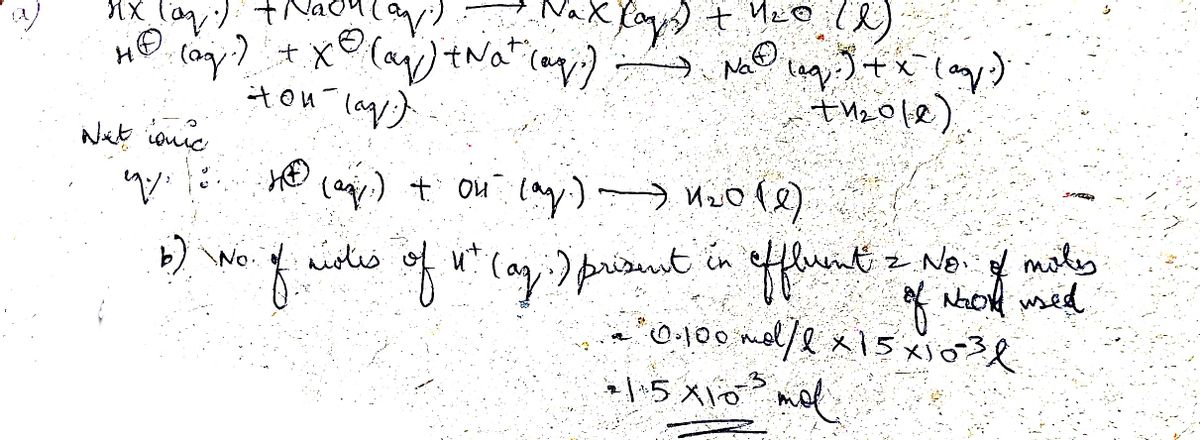The effluent from the column required 15.00 mL of 0.1000 M NaOH to neutralize. a) Write the net ionic reaction equation that occurs when the effluent is neutralized by the NaOH. For your convenience, the molecular equation is given below. Assume HX is a STRONG acid. HX(aq) + NaOH(aq) → NaX(aq) + 2H2O(I) How many moles of Htlag) are present in the effluent? Reference "Volumetric Analysis"
The effluent from the column required 15.00 mL of 0.1000 M NaOH to neutralize. a) Write the net ionic reaction equation that occurs when the effluent is neutralized by the NaOH. For your convenience, the molecular equation is given below. Assume HX is a STRONG acid. HX(aq) + NaOH(aq) → NaX(aq) + 2H2O(I) How many moles of Htlag) are present in the effluent? Reference "Volumetric Analysis"
Chemistry
10th Edition
ISBN:9781305957404
Author:Steven S. Zumdahl, Susan A. Zumdahl, Donald J. DeCoste
Publisher:Steven S. Zumdahl, Susan A. Zumdahl, Donald J. DeCoste
Chapter1: Chemical Foundations
Section: Chapter Questions
Problem 1RQ: Define and explain the differences between the following terms. a. law and theory b. theory and...
Related questions
Question
Please help.

Transcribed Image Text:Prelab Question #1:
A 10.00 ml sample of wastewater containing copper ion (Cu2*) was put on an ion exchange
column.
2 (resin•SO3)H + Cu2+ > Cu(resin•SO3)2 + 2H*
The effluent from the column required 15.00 ml of 0.1000 M NAOH to neutralize.
a) Write the net ionic reaction equation that occurs when the effluent is neutralized by the
NaOH. For your convenience, the molecular equation is given below. Assume HX is a
STRONG acid.
HX(aq) + NaOH(aq) → NaX(aq) + 2H20(I)
b) How many moles of H*(aq) are present in the effluent? Reference "Volumetric Analysis",
Chapter 4, Section 4.10 of the text
c) Calculate the molarity of the copper ion (Cu2*) in your wastewater sample. Hint: consider
the mole ratio between Cu²2+ in the wastewater sample and H* in the effluent as
represented in the equation
2 (resin•SO3)H + Cu?* → Cu(resin•SO3)2 + 2H*
Prelab Question #2: (See Special Project section “★Why are copper patinas colored?")
Complete this sentence: "Materials appear colored because they.."
Expert Solution
Step 1

Step by step
Solved in 2 steps with 2 images

Knowledge Booster
Learn more about
Need a deep-dive on the concept behind this application? Look no further. Learn more about this topic, chemistry and related others by exploring similar questions and additional content below.Recommended textbooks for you

Chemistry
Chemistry
ISBN:
9781305957404
Author:
Steven S. Zumdahl, Susan A. Zumdahl, Donald J. DeCoste
Publisher:
Cengage Learning

Chemistry
Chemistry
ISBN:
9781259911156
Author:
Raymond Chang Dr., Jason Overby Professor
Publisher:
McGraw-Hill Education

Principles of Instrumental Analysis
Chemistry
ISBN:
9781305577213
Author:
Douglas A. Skoog, F. James Holler, Stanley R. Crouch
Publisher:
Cengage Learning

Chemistry
Chemistry
ISBN:
9781305957404
Author:
Steven S. Zumdahl, Susan A. Zumdahl, Donald J. DeCoste
Publisher:
Cengage Learning

Chemistry
Chemistry
ISBN:
9781259911156
Author:
Raymond Chang Dr., Jason Overby Professor
Publisher:
McGraw-Hill Education

Principles of Instrumental Analysis
Chemistry
ISBN:
9781305577213
Author:
Douglas A. Skoog, F. James Holler, Stanley R. Crouch
Publisher:
Cengage Learning

Organic Chemistry
Chemistry
ISBN:
9780078021558
Author:
Janice Gorzynski Smith Dr.
Publisher:
McGraw-Hill Education

Chemistry: Principles and Reactions
Chemistry
ISBN:
9781305079373
Author:
William L. Masterton, Cecile N. Hurley
Publisher:
Cengage Learning

Elementary Principles of Chemical Processes, Bind…
Chemistry
ISBN:
9781118431221
Author:
Richard M. Felder, Ronald W. Rousseau, Lisa G. Bullard
Publisher:
WILEY